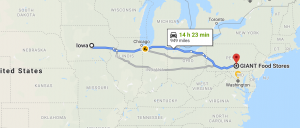For this blog post, I started by researching the almond milk that I have in my fridge which happens to be the unsweetened, original almond milk from Trader Joe’s. I didn’t really think much about this product when I was purchasing it, I just picked it up when I went to Trader Joe’s in MA before I returned to campus.
The main ingredient in this almond milk is almonds, as it should be. When I set out to discover the origin of the almonds in this Trader Joe’s beverage, I was surprised that I really could not find the location anywhere. For I company that prides itself on its transparency, this seemed strange. The side of the carton reads “Dist. & Sold Exclusively By Trader Joe’s Monrovia, CA 91016” so I am going to assume that the almonds come from California. Additionally, in my research, I came across one petition against how Wholefoods and Trader Joe’s market their pasteurized almonds as raw almonds directed towards an issue of almonds being grown in California.
According to one article, published by Columbia University, almonds are unsurprisingly the biggest cash crop in California, attributing for over 80% of the World’s almond production in 2014. California’s Central Valley offers ideal growing conditions for almond trees, however, almond requires huge amounts of water, a resource that is quickly depleting in California. According to the article, the amount of water required for almond trees not only causes environmental concerns but is an economic burden on the farmer who has to sink more money into the expensive water.

Another product that I eat frequently is the Stonyfield organic probiotic yogurt made with plain whole milk. This product claims to contain BILLIONS of probiotics per serving and I purchased it at Weis in Carlisle. I wanted to research this product because it was one of the companies interviewed in Food Inc. and I have listened to the “How I Built This” podcast where Gary Hirshberg discussed how he built the company from the ground up. The first ingredient in this product is “cultured pasteurized organic whole milk” and the only other ingredients it contains (aside from its live active cultures) are pectin, and Vitamin D3.
The milk for this yogurt comes from a variety of farms. According to the Stonyfield website, in 2014 the company created a CROPP Cooperative with milk from a network of organic dairy farms existing of 1,800 family farms. The company promotes the humane treatment of animals in addition to their organic practices. Although there are no additives, hormones or synthetic fertilizers involved in the production processes, not all of the Stonyfield cows are 100% percent grass-fed as indicated by the fact that the company now sells “grass-fed Greek” yogurt, indicating that other cows are most likely fed a mixture of grass and other feed like oats, soy, grains, etc.
The origin of Stonyfield milk is unknown as it comes from a cooperative of farms. However, the Headquarters are in Londonderry, NH.

The third food that I analyzed was the eggs I eat pretty much every morning. I am always at a dilemma with eggs because either the responsibly produced eggs are double the price or they contain plastic packaging. On this trip to the grocery store, I decided to go with the cheaper option with the cardboard packaging. These eggs are distributed by Foodhold USA, LLC in Landover, MD which appears to be a partner of the Giant food company. From what I found on the internet this company produces/distributes a lot of different products and is not generally well-liked with an extensive list of customer complaints. According to the American Egg Board, the majority of the country’s eggs are produced in Iowa. I was not able to find exactly where the eggs I purchased were coming from but I am going they were produced in the Mid-West region.
I was also not able to find information on how these eggs were produced, but I am assuming that it was more of a factory environment rather than a cage-free, pasture environment, treating the hens more as cogs on a wheel than living creatures. That being said, I did read an article detailing that Giant Food Stores will be transitioning to 100% cage-free eggs by 2022.

From this exercise, I discovered that I ate roughly 62 foods/ingredients over the span of 3 days. However, even after this research, I have found that I still do not know where a lot of my food comes from. Being a college student makes this even more difficult because I do not have the access to find out where the food I am consuming in the cafeteria is coming from.
Leave a Reply